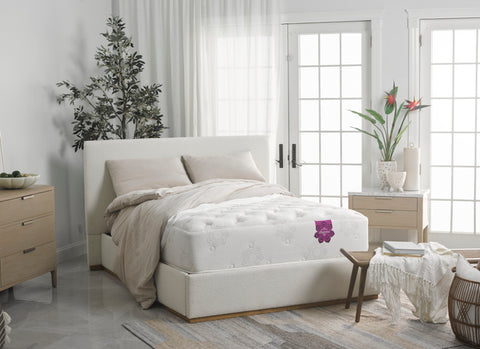
First, let’s examine a bit about latex: what it is, where it comes from and how it is sourced today.
Latex is a natural, organic product developed using the milk sap of the sustainable rubber tree (Hevea brasiliensis) which is sourced from Indonesia, Sri Lanka, Malaysia and Thailand.
Latex was first developed in the 1920’s by E.A. Murphywho was a British scientist employed by the Dunlop Company. It would be a few years later before latex was tested and developed for use in mattresses sometime in the early 1930’s.
Latex mattresses are offered today as a natural eco-friendly alternative to memory foam. Many consumers have experienced issues with memory foam, as the synthetic materials used to construct the foam emit off-gases that can irritate eyes and even affect breathing with allergy-like symptoms while you sleep. Latex mattresses are made using a healthier, more environmentally friendly material that provides an increased level of comfort with less movement and disturbance for you and your partner. They are also hypoallergenic and resistant to dust mites.
There are two main methods used today for producing latex used in mattresses: Dunlop and Talalay.
Dunlop Latex
The original process for creating latex, the Dunlop process involves whipping the rubber sap into a frothy blend, pouring it into molds, and baking. Dunlop latex tends to be more firm, heavier and more durable with the added benefit of longevity. It is generally not 100% natural latex, and the product can have issues with consistency, as the latex particles can settle towards the bottom of the mold while drying.
Talalay Latex
The Talalay method for producing latex was recently developed as an alternative to Dunlop, which many consumers found to be too dense, resulting in mattresses that were very firm. The Talalay process is similar to Dunlop, but a vacuum is applied to ensure that latex particles are evenly distributed, resulting in a product with a texture that is softer and more pillow-like.
It is important to note that both of these processes can be made from 100% natural latex, synthetic latex (from petroleum by-products), or a blend of both natural and synthetic. Many mattress manufacturers state that their products are 100% latex, but it is important to note that this does not always mean they are using 100% natural latex.
Mattresses that are made from blended latex generally contain approximately 30-40% natural latex with the remaining 60-70% comprised of synthetic latex and other fillers. They typically fall into a more moderate price range than 100% natural latex versions.
Latex Mattress Recommendations
When testing and researching latex mattress options as noted in our recent article, remember to compare comfort, longevity and warranty coverage to find the very best fit for your personal sleep needs. Ask your sales representative to share detailed information on the materials used in each mattress so you can be reassured you are buying the healthiest alternative for your sleep space.
PranaSleep Lotus "5 and 6 series"
Mattresses in the mid-price range, comprised of Talalay latex and super high-density performance foams.
PranaSleep "6th generation"
The finest blended Talalay latex mattresses combined with smart fabric for the ultimate sleep experience.
PranaSleep Om and Organics collections
Two options for the consumer looking for a mattress made from 100% natural latex.
Bonus Tip Certified natural organic latex is available, and these mattresses will fall into a higher price range due to the cultivation and production process required to authenticate the finished mattress.